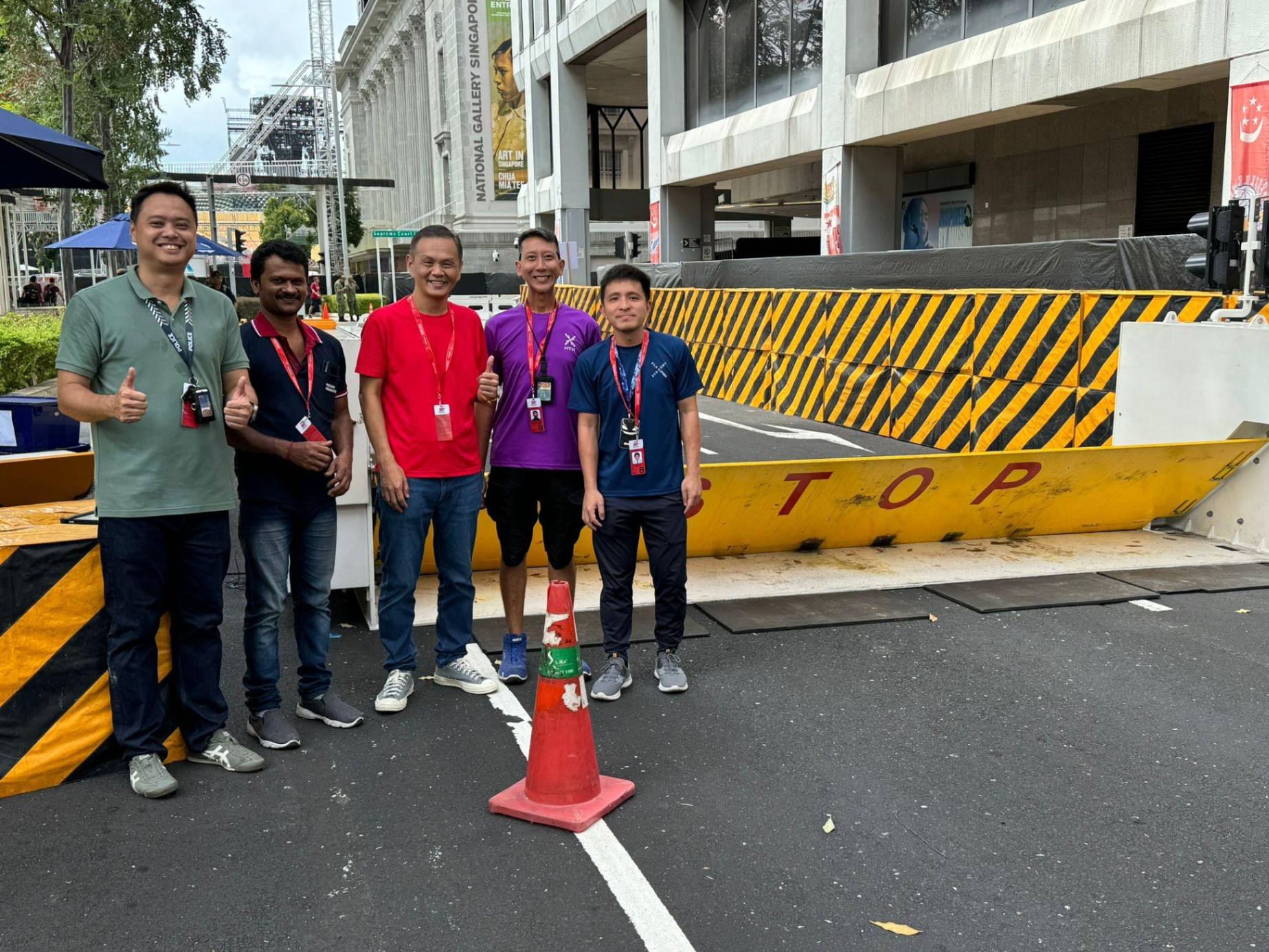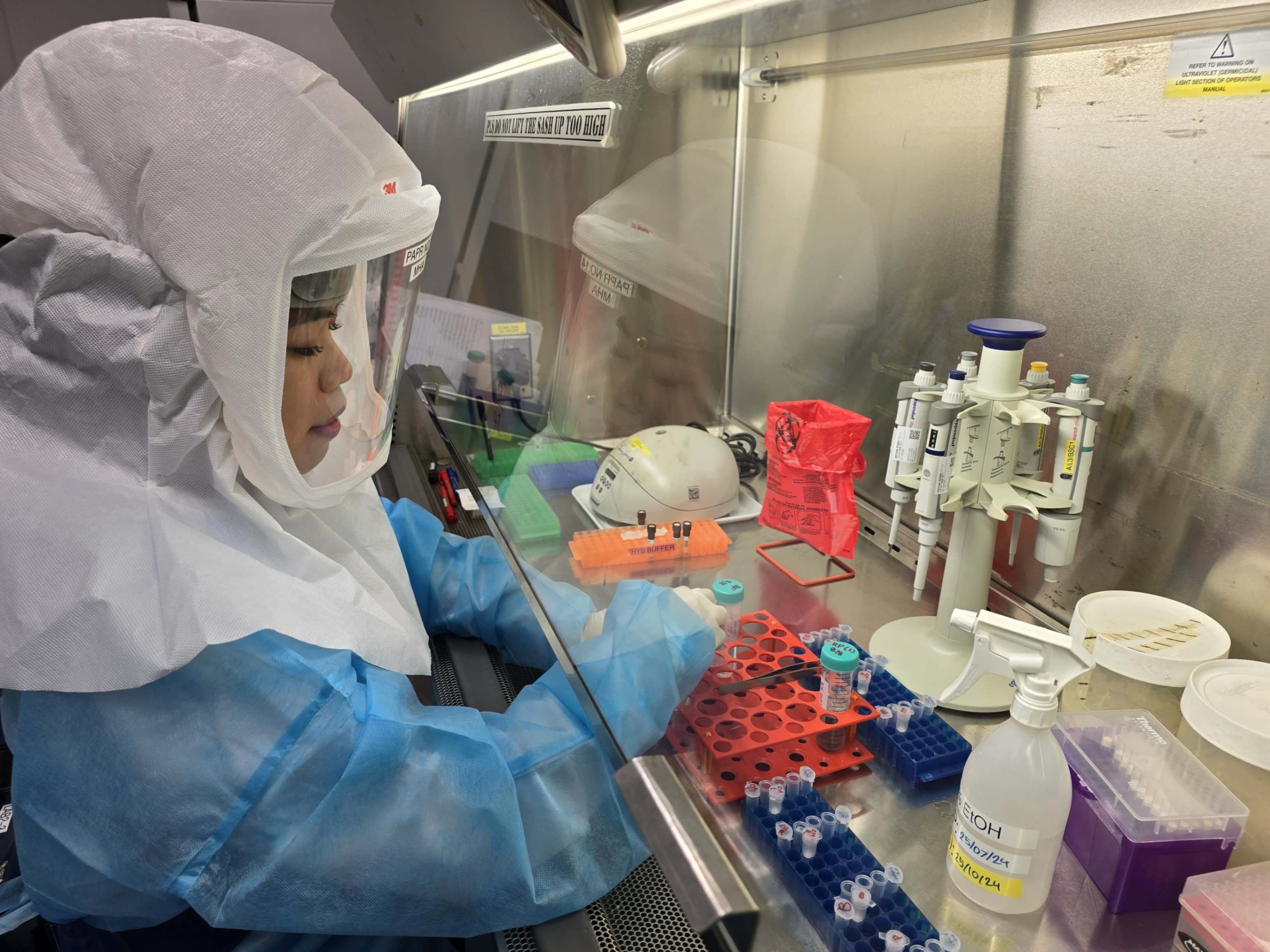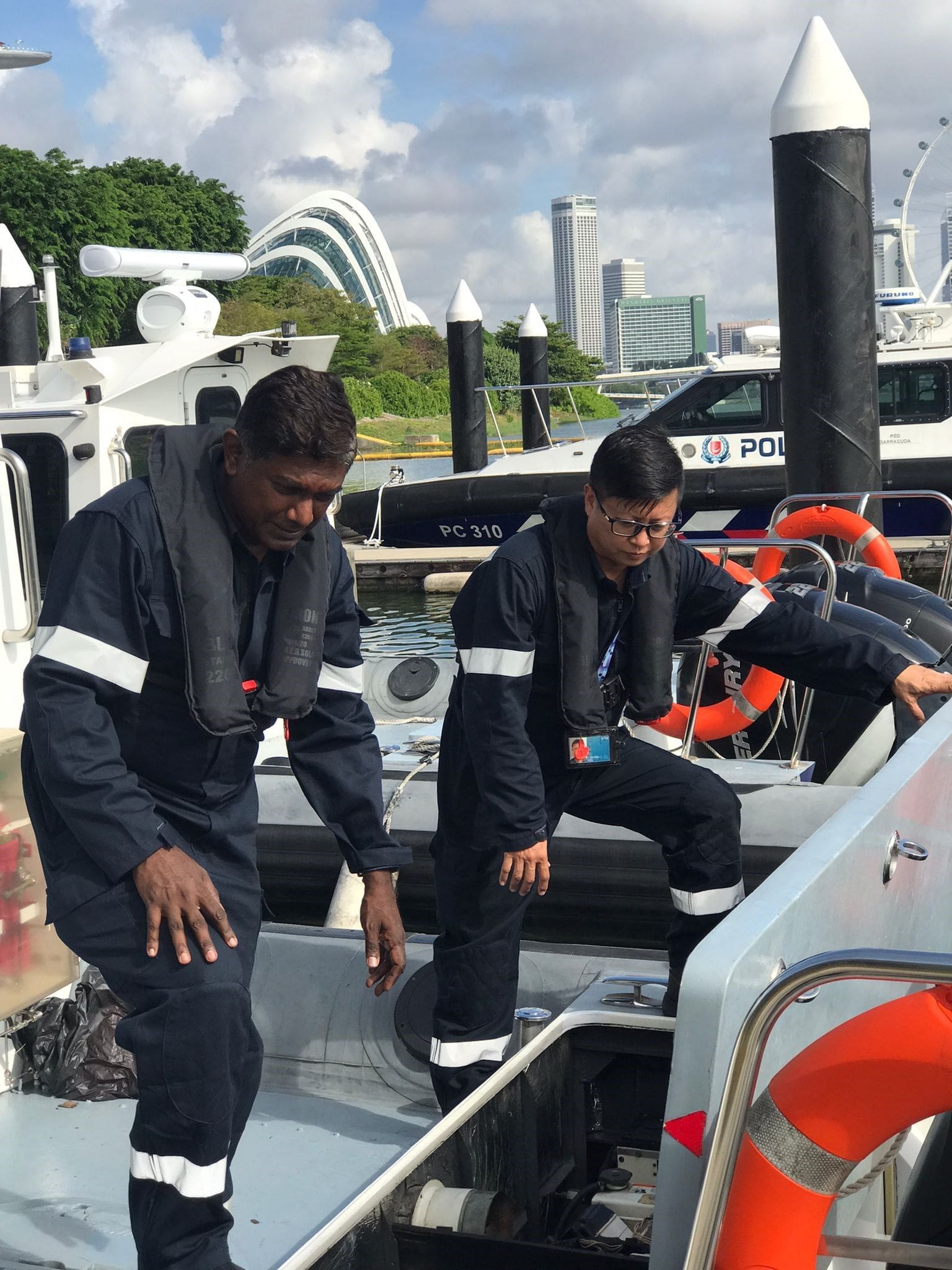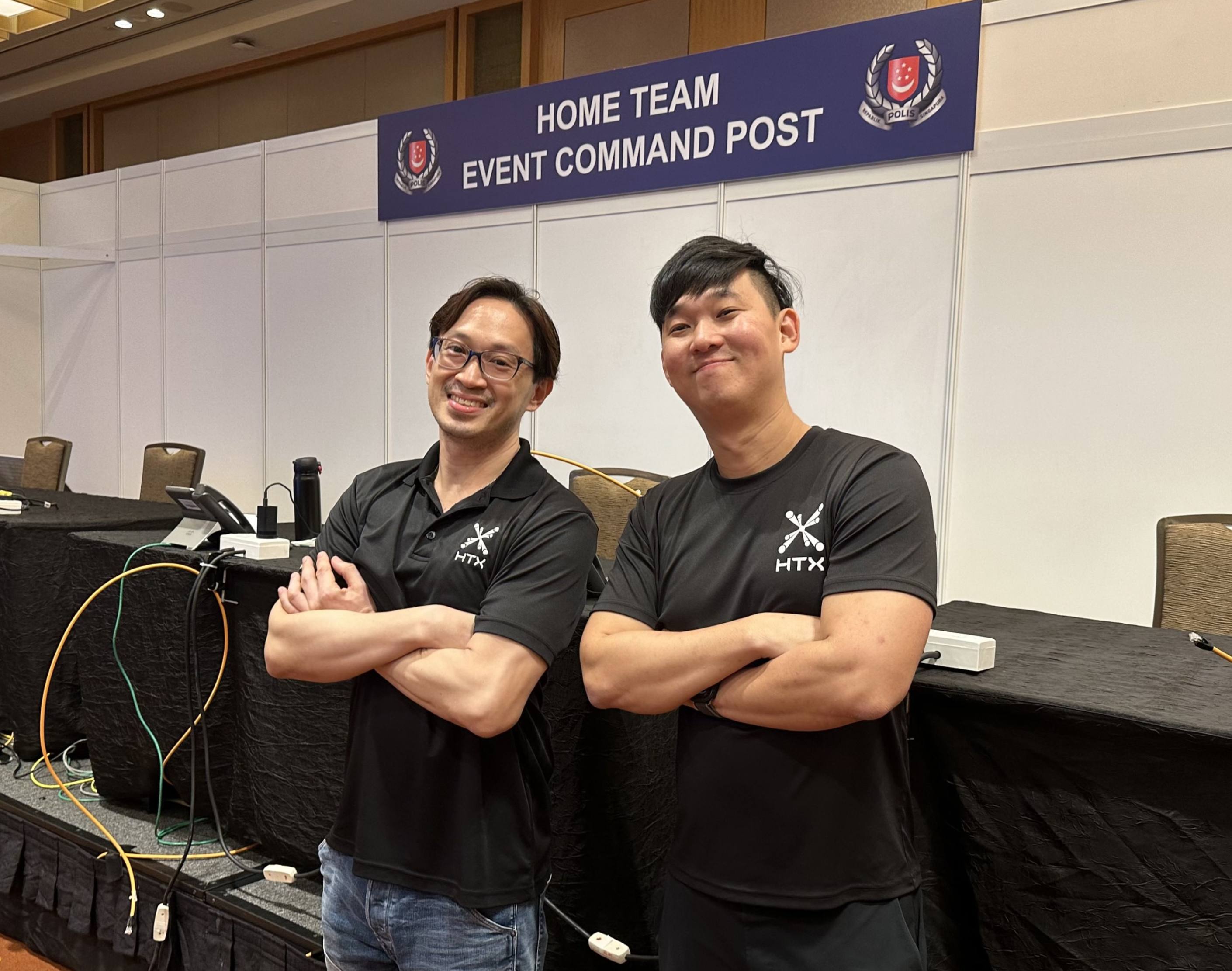While most of us enjoyed the National Day Parade (NDP) alongside our loved ones, many Xponents worked tirelessly behind the scenes to make the celebration a resounding success by securing the NDP venue from potential threats and bolstering the capabilities of our Home Team Departments.
Here’s a look at what our Xponents were up to.
Supporting safety and security measures

The Specialised Platform Systems team from HTX poses with a deployed MCB. (Photo: HTX)
HTX’s Specialised Platform Systems team oversaw the deployment of Mobile Crash Barriers (MCB) around key locations during NDP, keeping Singaporeans safe from vehicular terrorist attacks.
“These sturdy barriers can reduce or even fully mitigate vehicular threats. For example, if a vehicle carrying explosive devices tries to ram through an MCB, the barrier will stop the vehicle in its tracks,” said Oliver Lim, Engineer, Specialised Systems.
Before setting up these barriers, the team first performed a site recce a few months before the deployment of the MCBs. During this process, the team evaluated the suitability of the ground terrain, ensuring that the MCB is deployed on stable ground that will not sink under its weight.
After determining the ideal locations for MCB placement, the team conducted pre-deployment checks to guarantee that the MCB’s ramp and proximity sensors were functional.
“Although MCB deployment is time-consuming, I’m proud that our work keeps Singaporeans safe from terrorist attacks,” Oliver shared.

A CBRNE scientist analyses air samples for invisible bio-threats. (Photo: HTX)
While the Specialised Platform Systems team protects Singaporeans from visible threats, the CBRNE team conducts bio surveillance to protect Singaporeans from invisible bioterrorism threats.
For the NDP, the team screened for such threats with the help of bio samplers—devices that collect air samples. These air samples were then returned to the lab, where they were tested for bio-terrorism agents.
“Before NDP, we conducted site recce at various MRT stations and NDP sites and identified suitable locations for placement of the bio samplers. What’s most important is ensuring that the location has good airflow and a high amount of human traffic. Good airflow ensures that a sufficient volume of air passes through the bio sampler and this provides us with a sample representative of air in the area,” Yeow Siang Yun, Senior CBRNE Scientist, explained.
These bio samplers were then deployed a few days before NDP so that the team could collect background air samples. This provided CBRNE scientists with a benchmark for existing air conditions and helped confirm that no bio-threats are present before the event.
Similarly, during and after NDP, the team collected and tested air samples at intervals to facilitate the early detection of bio-terrorism threats.
“I know there’s a lot of work and time involved but I’m honoured to serve and protect Singapore. At such a major event like the NDP, bio-terrorism threats could create mayhem if they’re not detected early,” Charmaine Sim, CBRNE Scientist, shared.

Members of the Marine Platform Systems team conducts checks on PCG vessels. (Photo: HTX)
Also involved in the security of the NDP was HTX’s Marine Platform Systems team, which performed daily maintenance checks on Police Coast Guard (PCG) vessels that would be deployed to deal with hostile marine vessels. Regular maintenance checks on the vessels’ propulsion engines, generators, air conditioning and ventilation, and navigation and communication systems ensured that any potential defects would be quickly identified and fixed, allowing for the immediate deployment of PCG vessels.
Force multiplying our HTDs

Welcome to the NDP command post! (Photo: HTX)
The Policing Operation (Ops) Systems team sets up NDP command posts across Singapore, including cross-agency command posts like the Home Team Event Command Post, during major events like the NDP. These command posts provide HTD officers with a comprehensive overview of the situation on the ground and allow them to react swiftly to threats.
According to Edmund Ng, Senior Technical Officer, Policing Operations, setting up these command posts is no easy task due to the need to establish secure IT networks that allow communication between various Singapore Police Force (SPF) divisions.
“Before setting up the command post, we conduct site surveys with the appropriate communications network vendors to familiarise them with the site. The vendors will also highlight site issues to our team,” said Edmund.
Some the common issues, he pointed out, include poor communications coverage at the command post location. To deal with this, the Policing Ops Systems team must create a technical workaround to the limitation.
“In our line of work, we often race against the clock to deal with evolving situations. I’m grateful that no matter the situation, our team collaborates effectively to get it done.”
ICT Infrastructure
While the Policing Ops Systems team readies the NDP command posts and ensures that the front-end infrastructure is linked to the backend infrastructure, HTX’s ICT Infrastructure team connects various important networks to the backend infrastructure.
“Before NDP, we assess the operational areas and command posts to identify potential communication gaps. This helps us proactively pinpoint critical communications coverage blind spots and implement solutions to optimise signal strength,” Jimmy Lim, Engineer, Central Services, explained.
During NDP, the team ensures the connectivity of the Whole of Government (WOG) and MCN2 networks to backend infrastructure. The MCN2 network plays a critical role in the NDP as it is a secured network that enables the SPF, the Singapore Civil Defence Force (SCDF), the Immigration and Checkpoints Authority (ICA) and Singapore Armed Forces (SAF) officers to communicate with one another.
Both networks are monitored continuously, with the WOG network being closely monitored by a suite of security tools running round the clock. The tools trigger security alerts if threats are detected. In the event of such incidents, the team will immediately isolate the command post network to ensure the continuity of NDP’s ICT operation support.
“We often sleep with one eye open as we get last-minute calls from stakeholders to investigate ICT issues. But ensuring all services run like clockwork is just a small contribution to safeguarding Singapore,” Jimmy added.
Civil Defence (CD) Ops Systems
The Civil Defence (CD) Ops Systems team was also present at SCDF command posts to support the SCDF’s operation systems.
“During the NDP previews and NDP itself, we maintain and manage key Ops Systems within the command post by working closely with vendors and performing thorough system checks,” Vincent Ng, Lead Engineer, Civil Defence Ops Systems shared.
If there is a system fault or breakdown during the parade itself, the team works with system vendors and SCDF users to promptly troubleshoot and resolve such issues, minimising the impact on SCDF operations.
“I find our work meaningful even though we’re not on the frontlines with our SCDF colleagues. I know that by providing reliable and seamless support to the SCDF, I’m doing my part to keep Singaporeans safe,” Vincent said.
Cyber Security Operation Systems
Located beyond the Command Posts, HTX’s Cyber Security Ops Systems team defends all MHA ICT systems from cybersecurity threats.
According to Lucas Kan, Head, Cybersecurity SOC Ops, this team is stationed at the Security Operations Centre (SOC), one of the four operation centres under the Home Team Sustainment Centre.
“While we routinely check MHA’s ICT systems, we are on heightened alert during high-profile events like NDP as malicious actors are more likely to carry out opportunistic attacks and attempt to disrupt MHA systems,” he said.
During these heightened alert periods, the team carries out proactive checks on the health of public-facing systems, like MHA websites, to swiftly detect potential DDOS attacks or web defacement.

The Home Team Sustainment Centre Operations Room. (Photo: HTX)
Crucially, the team also screens for unauthorised activities on MHA’s key systems.
“We monitor the security events of ICT systems via our Security Information Event Monitoring (SIEM) system. SIEM alerts us if there are any suspicious activities, like unauthorised sign-ins or malware activity. Our analyst then delves deeper into the logs to detect other unusual activities, like the copying of suspicious files or installation of unauthorised software,” he added.
If a cybersecurity incident is detected, HTX’s team works closely with various Home Team Department Security Incident Response Officer (SIRO) teams to address these incidents with incident response playbooks—ensuring minimal disruption to Home Team operations.